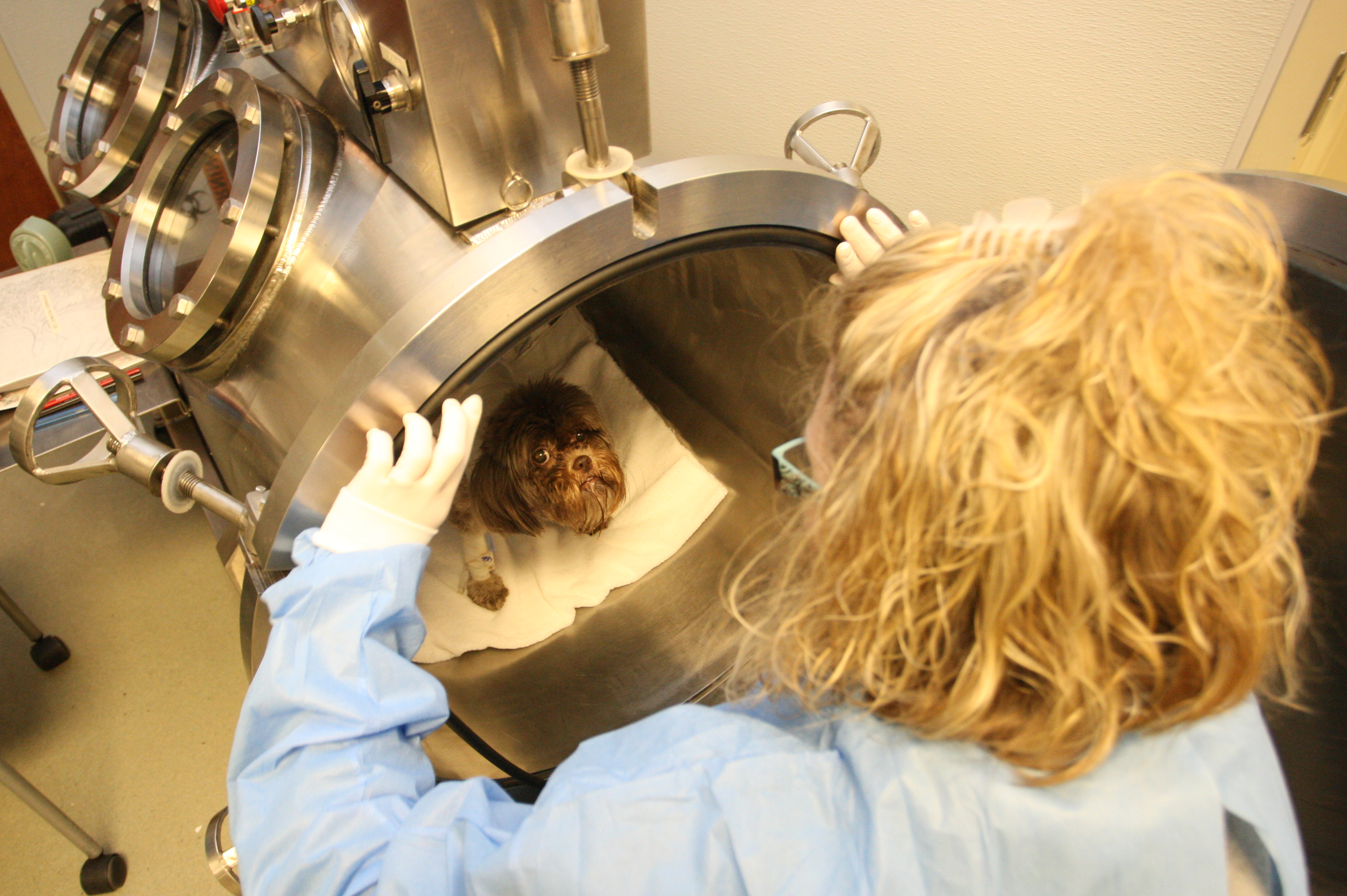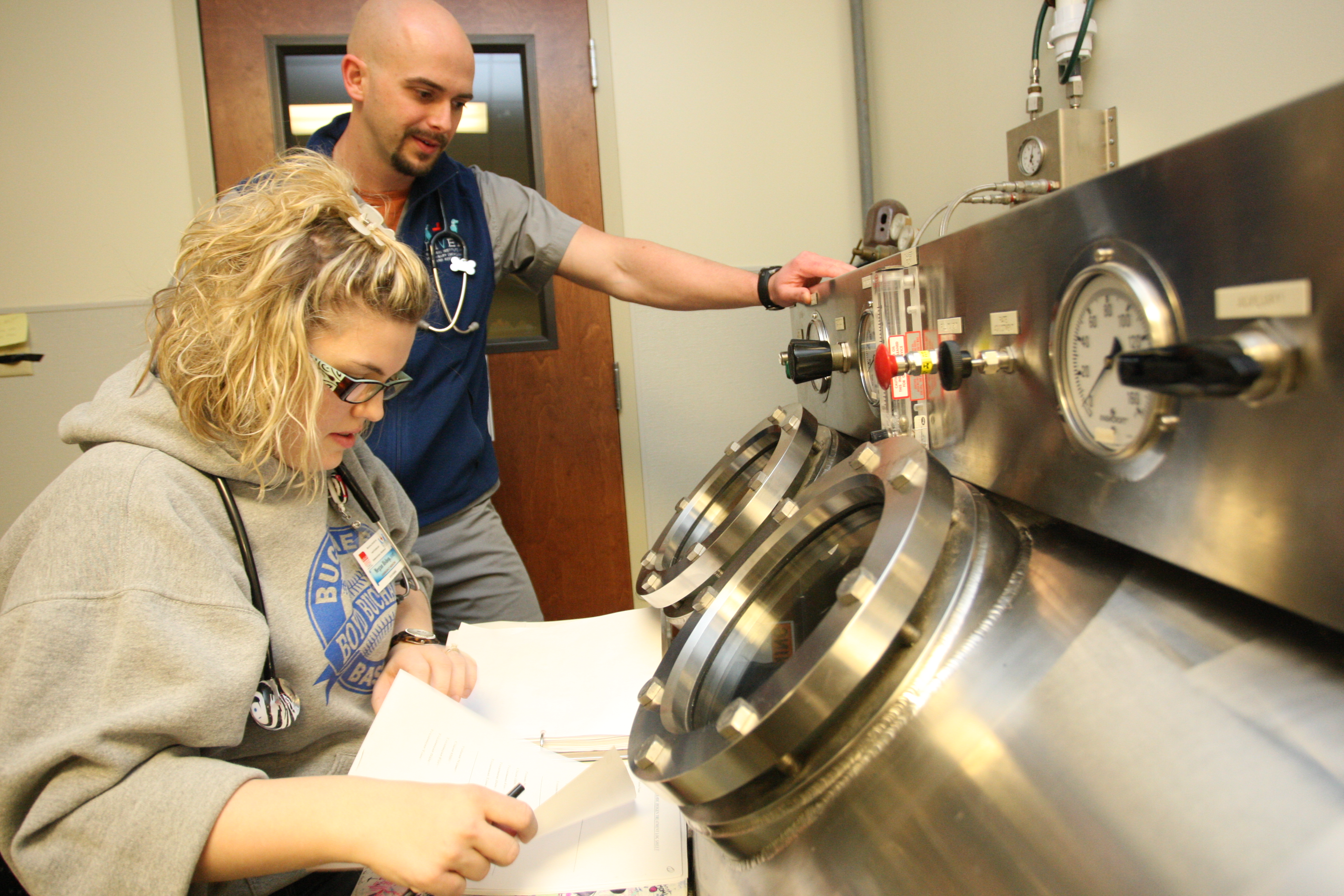Chattanooga hyperbaric chamber helps ailing pets (with video)
Friday, January 1, 1904
 Veterinarian technician Megan Bishop prepares the hyperbaric chamber for Lexie the Yorkshire terrier's treatment. The Regional Institute for Veterinary Emergency and Referrals is one of two Tennessee veterinary clinics that has a hyperbaric chamber, a device traditionally used to treat scuba and deep-sea divers for the "bends."
Veterinarian technician Megan Bishop prepares the hyperbaric chamber for Lexie the Yorkshire terrier's treatment. The Regional Institute for Veterinary Emergency and Referrals is one of two Tennessee veterinary clinics that has a hyperbaric chamber, a device traditionally used to treat scuba and deep-sea divers for the "bends."Lexie was on the losing end of a dogfight.
Worst was a punctured lung. As a result, the 13-pound Shih Tzu/schnauzer mix developed a life-threatening, drug-resistant infection.
Lexie's owners, Bert and Sharon Brown of Ooltewah, took her to the Regional Institute for Veterinary Emergencies and Referrals (RIVER) on Amnicola Highway, where she received treatments in one of only two hyberbaric chambers used by veterinarians in Tennessee. The other chamber -- which provides super-high levels of oxygen -- is at the University of Tennessee College of Veterinary Medicine in Knoxville.
Bert Brown credits the hyberbaric chamber for saving Lexie's life.
"It was scary when we first brought her in," he recalls. "She was attacked by a stray dog that weighed at least 150 pounds. It was like a bear attacking a human. The doctors told us she had about a 50/50 chance of survival.
"The treatments absolutely saved her life," he says.
Today, Lexie is home and healing nicely, says veterinarian Michael Lane, president of the Hamilton County Veterinary Medical Association and an associate of Regional Institute for Veterinary Emergencies and Referrals.
While the hyberbaric chamber at RIVER is used for cats and dogs, chambers in other locations such as universities are used to treat horses and farm animals, says Lane."It primarily helps by increasing oxygen levels in wounds and inflammatory tissues. However, it speeds healing, decreases edema (swelling)" and makes antibiotics more effective, he says.
Lane says the cost is $110 for the first treatment and about $50 for subsequent treatments. Lexie required 12 treatments.
Justin Shmalberg, a veterinarian and professor at the University of Florida's College of Veterinary Medicine in Gainesville, says the college will begin clinical trials this summer to determine how the hyperbaric chamber is effective in speeding recoveries and healing animals, according to The Associated Press.
"Any place we have swelling of tissue, we oftentimes are thinking about the hyperbaric chamber as something we could do to decrease that," he says.
At RIVER, the cylinder-shaped chamber, which cost around $90,000, is designed specifically to treat small, medium and large animals, up to about 180 pounds.
RIVER acquired its chamber in 2007 and it has been an integral part of its medicine ever since.
"It's constantly in use," Lane says. "The cases are amazing. Animals that may have lost tissue in the past have been able to be treated with success in our chamber. Snake bites, antibiotic-resistant infections and neurologic injuries seem to have the most amazing results."
Hyperbaric chambers have been used for decades to treat scuba and deep-sea divers with the "bends" -- nitrogen in the bloodstream created by coming up too fast from high-pressure depths -- as well as people with burn injuries and other traumatic injuries. But use for pets is recent.
"Hyperbaric oxygen chambers are becoming more well-known and popular amongst veterinarians, but there are still very few facilities in the country that offer the treatments," Lane says. "The more veterinarians are learning about the treatment, the more popular they will become."
Inside the chamber, oxygen is present at much higher pressures than normal, so larger amounts are pumped into the body through breathing and cellular absorption. The bloodstream, lymph system and cerebrospinal fluid carry the oxygen, "enabling oxygen to reach damaged tissue at least three to four times faster than normally diffused by red blood cells," according to hyperbaricveterinarymedicine.com.
Lane says the number of treatments -- known as "dives" -- needed by an animal depends on the severity of its injuries.
"Treatments range from one to two hours in the chamber and normally occur once or twice a day dependent upon the patient's condition," he says. "Total number of dives may vary from one to 20 or more.
"I occasionally wish we had more than one chamber," he adds. "Sometimes we have more pets than we can squeeze into treatments in a 24-hour period."
The Regional Institute for Veterinary Emergency and Referrals is a referral hospital, Lane says, so "most all of our patients have a primary care veterinarian that has referred their patient for this therapy."
Megan Bishop, a licensed veterinarian technician at RIVER, says "there's not a single day we don't use the chamber" and she notes that, when the animals are inside, they're monitored through a large glass port in the side of the chamber.
"They're comfortable in the chamber," Bishop says.
Brown says he and his wife visited Lexie twice a day during her stay at RIVER.
"I've loved animals all my life and I'm grateful that, because of them, my wife and I still have Lexie."
Contact staff writer Karen Nazor Hill at khill@timesfreepress.com or 423-757-6396. Follow her on Twitter at twitter.com/karennazorhill. Subscribe to her posts on Facebook at www.facebook.com/karennazorhill.


